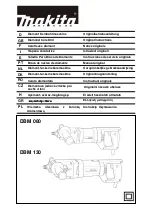
910161
Hydraulic Rail Drill
Phone: (262) 637-9681
Email:
1.2023 Rev 3.1
Original Instructions
Page 22
Troubleshooting
Stop and depressurize the hydraulic system before connecting or
disconnecting a tool. Failure to follow these instructions can lead
to severe personal injury.
Read and follow the instructions in this manual for the proper way
to connect and disconnect tools from the hydraulic system.
1. The tool must be connected to the correct power source system. Verify the hydraulic power source
system matches the tool requirements.
2. Verify that the pressure and return hoses are connected properly to the tool and hydraulic power
source ports.
3. The hydraulic power source reservoir must be filled to full level with hydraulic fluid.
4. After verifying the above, start the power source flow. All power sources shut-off devices must be
engaged or opened (clutch engaged, separate ON/OFF valves open, etc.).
5. Check the tool to see it if operates
Note:
lf the tool does not operate, it will be necessary to determine where the problem exists (i.e., in the
tool, hoses, or hydraulic power source).
Determining the Problem
Area
1. Stop the power source.
2. Depressurize the system and allow to cool.
3. Disconnect the existing tool from the hoses and power source.
4. Stop the power source flow.
5. Disconnect the existing hoses from the known, properly operating tool and power source.
6. See the tool's operator manual for the correct disconnect Procedure.
7. Connect a different set of hoses to the known, properly operating tool and power source.
8. Start the power source flow.
lf the known, properly operating tool operates with the different set of hoses, the problem is in the
disconnected hoses.
lf the known, properly operating tool does not operate, the problem is in the power source. See your
power source operator's manual for troubleshooting.
lf, after following all steps in the Troubleshooting section, it has been determined that the problem lies
with the tool, proceed to the Troubleshooting Guide. Use of the Troubleshooting Guide will help you
identify and determine the cause of the problem.
Note:
lt is not recommended that the end-user attempt to perform repairs, as special tools and
procedures are required.
Excess heat may be generated through any combination of pump inefficiencies, oil bypassing over relief
valves, pre-existing flow controls, or unusual restrictions in the system. Where these and other possible
inefficiencies exist, substantially larger reservoirs and/or coolers may be required.
Should you have any problems or questions with your Rail Drill, please do not hesitate to contact the
Racine Railroad Products.










































